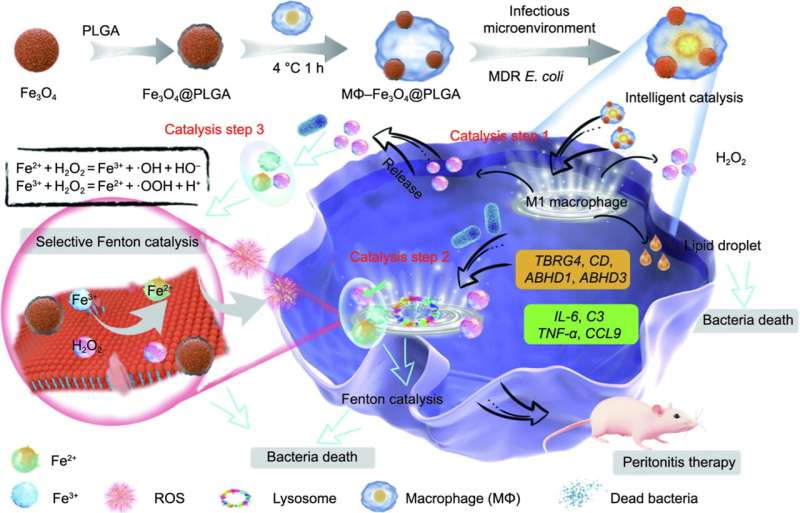This article has been reviewed according to Science X's editorial process and policies. Editors have highlighted the following attributes while ensuring the content's credibility:
fact-checked
proofread
Scientists discover biomimetic macrophage technology to combat antibiotic resistance

A research team led by Shuilin Wu at Tianjin University, China, has made a discovery in the field of intelligent catalysis. Their research article titled "Biomimetic Macrophage–Fe3O4@PLGA Particle-Triggered Intelligent Catalysis for Killing Multidrug-Resistant Escherichia coli" has been published in the journal Engineering.
Infections caused by multidrug-resistant (MDR) Gram-negative bacteria, such as MDR Escherichia coli (E. coli), pose a significant challenge to health care professionals worldwide.
The lack of safe antibiotics and the high fatality rates associated with anti-infection therapies have prompted researchers to explore innovative solutions. The research team at Tianjin University has developed a biomimetic intelligent catalysis approach inspired by the selective biocatalytic property of macrophages, which shows promise in combating MDR E. coli infections without harming normal cells.
The intelligent catalysis system consists of two main components: a living macrophage (MΦ) acting as an intelligent controlling center and Fe3O4@poly(lactic-co-glycolic acid) (PLGA) nanoparticles functioning as a Fenton reaction catalyst.
The MΦ–Fe3O4@PLGA particles, also referred to as intelligent catalysis particles, exhibit selective biocatalysis activity against MDR E. coli by producing hydrogen peroxide (H2O2) and lipid droplets (LDs). RNA sequencing data analysis revealed that this process activates lipid metabolism and glycan biosynthesis and metabolism pathways.
The H2O2 generated by the intelligent catalysis particles reacts with Fe3O4@PLGA to form highly toxic hydroxyl radicals (•OH), while the LDs contain antimicrobial peptides that specifically target MDR E. coli.
The combination of •OH and antimicrobial peptides effectively combats MDR E. coli, resulting in an impressive antibacterial efficiency of 99.29% ± 0.31% in vitro. Furthermore, the intelligent catalysis function of the MΦ–Fe3O4@PLGA particles remains intact even after several passages, indicating their long-term effectiveness.
The potential of biomimetic intelligent catalysts extends beyond the treatment of infections caused by MDR bacteria. The concept holds promise for addressing other diseases as well. The research team's findings pave the way for the development of innovative therapies that leverage the properties of macrophages and nanoparticles to combat various diseases.
Nan Zhang, editor of the subject of chemical, metallurgical, and materials engineering of Engineering, expressed optimism about the future of biomimetic intelligent catalysis.
"This research demonstrates the remarkable potential of MΦ–Fe3O4@PLGA particles as effective and safe antibacterial agents. The fact that PLGA and Fe3O4 nanoparticles have already been approved for use in humans by the US FDA further enhances the prospects of its approach for clinical applications."
While the research presents exciting possibilities, the clinical application of living cells is currently limited by culturing conditions. However, the team's pioneering work serves as a foundation for further exploration and development of biomimetic intelligent catalysis systems for a wide range of diseases.
More information: Jieni Fu et al, Biomimetic Macrophage–Fe3O4@PLGA Particle-Triggered Intelligent Catalysis for Killing Multidrug-Resistant Escherichia coli, Engineering (2023). DOI: 10.1016/j.eng.2023.05.022
Provided by Engineering




















